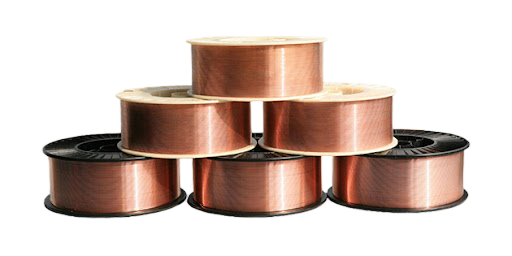
CuSi3 welding wire is a silicon bronze welding wire that is widely used in various welding applications due to its excellent fluidity, mechanical properties, and corrosion resistance. Below is a table summarising its key information for quick reference:
Characteristic Dimension Detailed Description/Parameters Notes/Standards
Common Name CuSi3 welding wire Also known as silicon bronze welding wire, ERCuSi-A welding wire (AWS A5.7 standard)
Corresponding Standards:
GB/T9460: HSCuSi
AWS A5.7: ERCuSi-A
DIN 1733: SG-CuSi3 Compliant with multiple international standards
Main Chemical Composition Copper (Cu) Balance
^ Silicon (Si) 2.8–4.0%
^ Manganese (Mn) ≤1.5% (slight variations exist across different standards)
Key Physical Properties Density Approximately 8.5 kg/dm³
^ Solidus Temperature Approximately 910 °C
^ Liquidus Temperature Approximately 1025 °C
^ Tensile Strength 330–370 N/mm²
^ Elongation Approximately 40%
^ Hardness 80–90 HB
Typical applications Suitable materials Copper-zinc alloys (brass), low-copper alloys
^ Application processes MIG welding (commonly used for galvanised sheets), TIG welding (preheating required for large areas)
^ Special applications Overlay welding of low-alloy steels, non-alloy steels, and cast iron
🧰 How to select and use When selecting welding wire, consider the following points:
· Certification standards: Ensure the product meets the required standards (e.g., AWS A5.7 or DIN 1733).
· Specification matching: Select the appropriate diameter and packaging specifications based on the welding process (MIG or TIG). Common MIG welding wire diameters include 0.8 mm, 1.0 mm, 1.2 mm, 1.6 mm, etc., typically packaged in spools; TIG welding wires are typically straight rods, with common diameters including 1.6mm, 2.0mm, 3.0mm, etc.
⚠️ Operational Precautions
· Preheating: When performing large-area TIG welding, it is recommended to preheat the workpiece.
· Pulse Arc: When performing multi-layer welding on steel, using pulse arc welding can help achieve better welding results.
· Ventilation and Protection: Ensure proper ventilation in the work area during welding, and operators should wear appropriate protective gear (such as welding masks, gloves, and protective clothing).
· Clean the Workpiece: Thoroughly clean any oil, oxide layers, or other contaminants from the welding area before welding to ensure welding quality.

